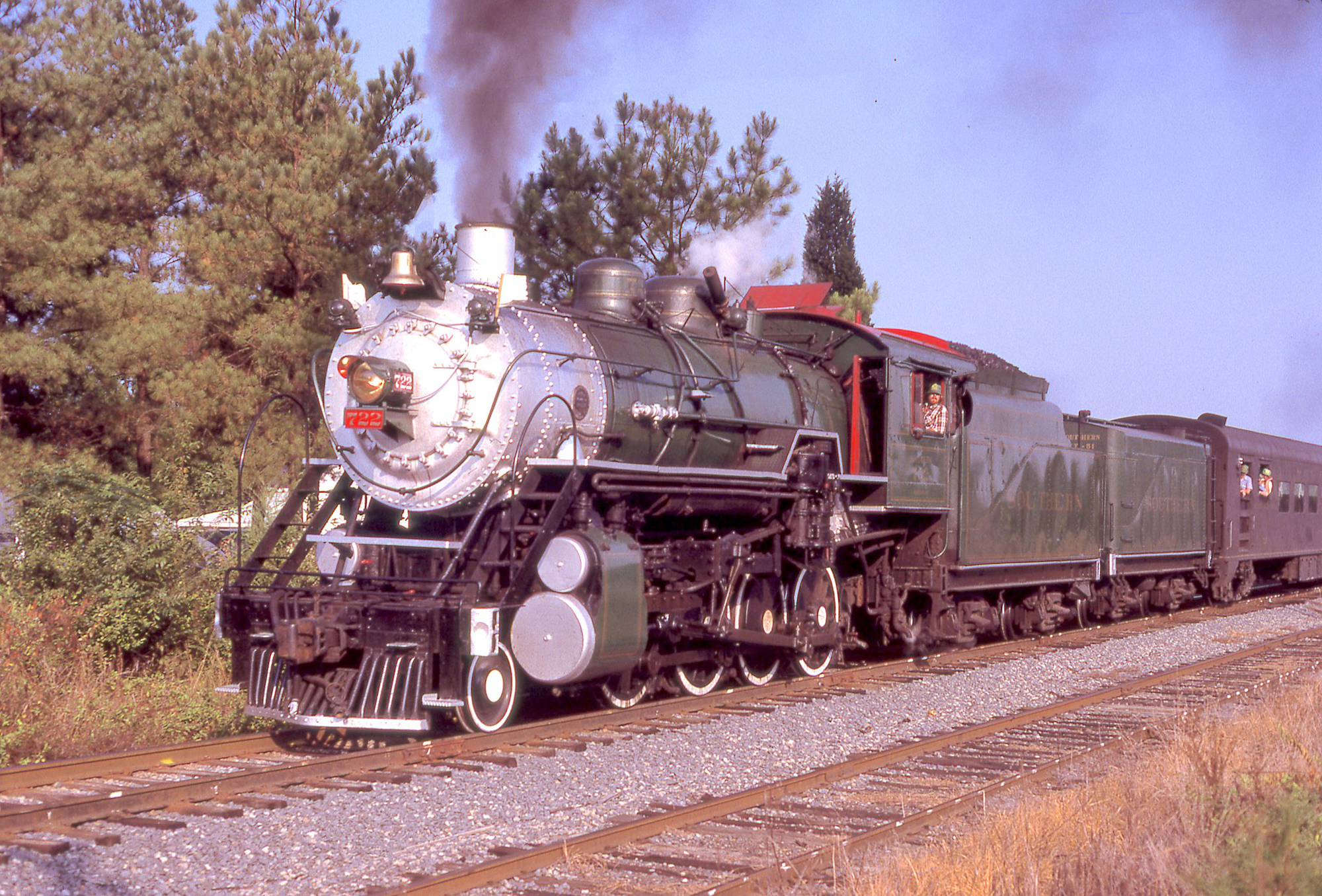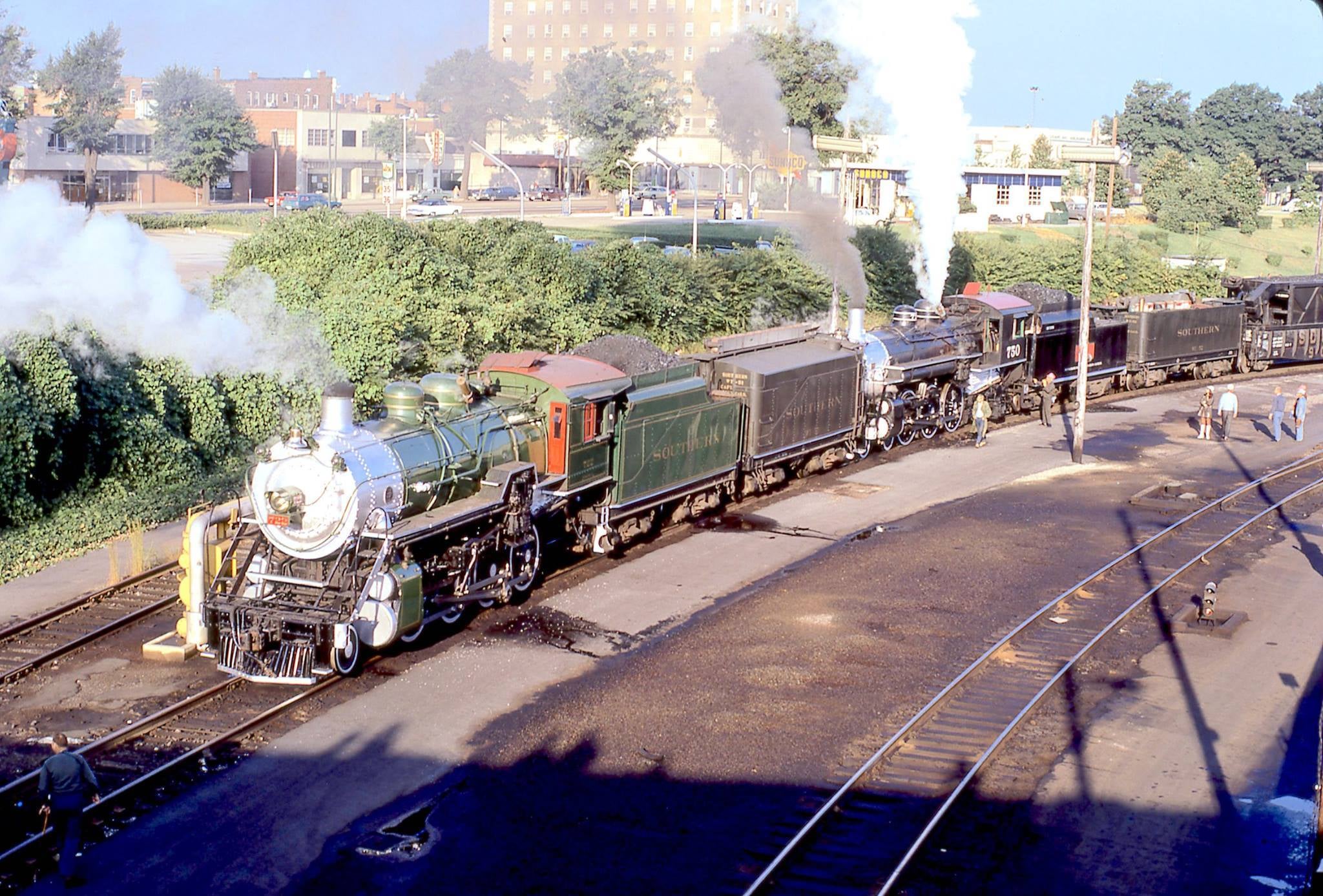Southern No. 722: A Star Locomotive Since 1970
Last revised: August 25, 2024
By: Adam Burns
Southern 722 is a 2-8-0 steam locomotive built in 1904 by the Baldwin Locomotive Works. It was operated by the Southern Railway in the United States until retired from service in 1952.
Following a second life in freight service on the East Tennessee & Western North Carolina from 1952-1967, it returned to the Southern for the railroad's steam program. It continued to lead special fan trips over the system until 1985 when it was retired and sat on display at the Tennnessee Valley Railroad Museum.
The locomotive was then donated to the City of Asheville, North Carolina in 1992 where it was displayed in a park until 2000. That year it was acquired by the Great Smoky Mountains Railroad (GSMR) for a complete restoration and eventual operation.
Today, the locomotive still resides at the GSMR and its restoration finally began in May, 2023. The railroad states they hope to have the locomotive fully operational once again by 2026.
Photos
 Southern #722 leads an excursion at Garner, North Carolina in November, 1981. Warren Calloway photo.
Southern #722 leads an excursion at Garner, North Carolina in November, 1981. Warren Calloway photo.Operational History
Southern 722 is a remarkable 2-8-0 steam locomotive, manufactured by the Baldwin Locomotive Works, often regarded as the finest steam locomotive manufacturer during the 20th century.
After its completion in 1904, 722 served a crucial role in the operations of Southern's system. The little Consolidation was renowned for powerfully hauling both freight and passenger services across key routes, delivering distinguished performance for nearly five decades.
722 falls under the 2-8-0 wheel arrangement category, also called "Consolidation" type in the Whyte system of classification. This locomotive belongs to the Class Ks-1, signifying a certain set of design and performance characteristics crucial to its operational identity.
Despite its reliable service, 722 experienced an initial retirement by the Southern in 1952, largely due to the shift in railway technology and the advent of more modern, efficient diesel-electric locomotives.
 In 1966, Southern Railway launched a heritage steam program which continued through the Norfolk Southern era until 1994 (and again briefly in the 2010's). Here, Southern 2-8-0 #722 and Savannah & Atlanta 4-6-2 #750 steam through Broad Street Station in Richmond, Virginia during 1971. Warren Calloway photo.
In 1966, Southern Railway launched a heritage steam program which continued through the Norfolk Southern era until 1994 (and again briefly in the 2010's). Here, Southern 2-8-0 #722 and Savannah & Atlanta 4-6-2 #750 steam through Broad Street Station in Richmond, Virginia during 1971. Warren Calloway photo.Excursion Era
In August, 1952 the locomotive was retired from service and three months sold to the East Tennessee & Western North Carolina (becoming #208) along with sister 2-8-0 #630 (which became #207), where it continued to operate in freight service, reflecting its undeterred resilience and mechanical robustness.
In the late 1960s, the Southern recognized the historical value of steam locomotives and initiated a steam program. As part of this initiative, 722 and 630 were both traded back to the Southern on December 8, 1967.
During an initial inspection of both locomotives it was determined 630 was in much better condition and returned to lead excursions in Februrary, 1968.
However, 722 needed a new firebox and after an extensive overhaul, finally made its first public excursion in September, 1970. That month it, along with 630, led a fan trip for the National Railway Historical Society near Charleston, South Carolina
The locomotive continued leading excursions on and off for the next 15 years until November, 1985 when she was retired and subsequently sat on display at the Tennessee Valley Railroad Museum.
At A Glance
Great Smoky Mountains Railroad
After its final retirement, 722 sat on display as a static exhibit in Asheville, North Carolina. Nestled among the city's displays of historical marvels, the locomotive served as a vibrant symbol of America's rich rail heritage.
Following a long display stint, locomotive was acquired by the Great Smoky Mountains Railroad (GSMR) in 2000, echoing the locomotive's undying relevance in the tapestry of American rail history.
Today, current restoration efforts by the GSMR aim to breathe new operational life into 722. The GSMR team, utilizing both traditional wisdom and modern methods, is diligently working to restore the locomotive to fully functional condition, a fitting new chapter for this stalwart of the Southern Railway.
The story of 722 is a testament to the locomotive's historical significance for the Southern Railway. Its service spanning several decades not only speaks to its mechanical resilience but also underlines its integral role within the railway's operational history.
Mirroring the broader narrative of American rail history, the journey of 722 encapsulates the growth and evolution of the railway sector, from the steam era's peak to the next-gen shift toward diesel-electric technology.
Southern 722's contribution to the Southern Railway's steam program underscores its enduring relevance. As the program aimed to foster a deeper understanding and appreciation for rail history, the locomotive often served as the star of these endeavors.
During its stint with the East Tennessee and Western North Carolina Railroad, 722 not only continued its freight haul duties but also added to its repertoire, the title of an excursion locomotive, further anchoring its historical legacy.
The dedicated mission of the Great Smoky Mountains Railroad, to rehabilitate 722, speaks volumes about the locomotive's value. Restoring it to its operational glory provides a rare and unparalleled opportunity for rail enthusiasts and historians to relive the golden age of steam.
Much like other steam giants of its era, Southern 722 stands as a living testament to the ingenuity of early-century locomotive manufacturing. Baldwin Locomotive Works did not merely supply a machine to the Southern Railway, but a workhorse that became an integral part of the American cultural fabric.
The 'Consolidation' locomotive's operational resilience under various ownerships and different railway settings bear witness to its versatile, robust design and engineering prowess.
Quadraplex 2-8-0 locomotives like the 722 played a pivotal role in the rapid industrialization and westward expansion of the United States. They were the behemoths that powered progress, quite literally laying the tracks for the future.
Through its endurance and revival efforts, Southern 722 symbolizes the persistent influence of the 'steam era' on contemporary rail operations. Its ongoing restoration is a nod to the days when steel giants powered by fire and steam charted the course of our country.
Today
Southern 722's storied journey loads it with historical mystery, intrigue, nostalgia, and an unwavering sense of adventure. It is an evocative symbol of an era marked by mechanical wonderment and the country's relentless progress.
The detailed focus on 722, its performance, and its importance to the Southern Railway and Great Smoky Mountains Railroad underlines the locomotive's significant footprint in the annals of America's rail history.
722 continues to offer generations a glimpse into an era of mechanical marvels and human resilience. Its enthralling tale of service, retirement, display, and restoration is a lasting testament to the time when steam ruled the railways, serving as an endearing, enduring reminder of our heritage.
